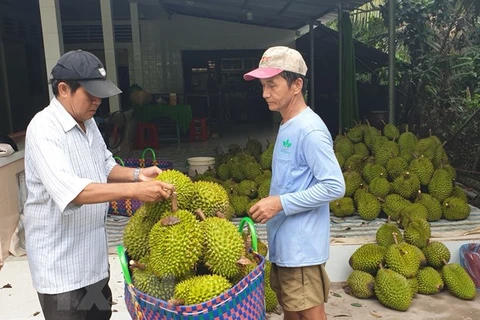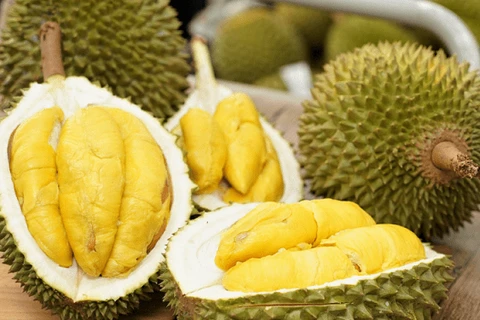 The protocol specifically stipulates the management of planting, packing and processing areas, inspection and quarantine of Vietnamese durian exporting to China (Photo: Vietnamplus)
The protocol specifically stipulates the management of planting, packing and processing areas, inspection and quarantine of Vietnamese durian exporting to China (Photo: Vietnamplus) Hanoi (VNA)- Durian will be the 11th Vietnamese fruit to enter the Chinese market via official channels, following a protocol signed by Minister of Agriculture and Rural Development Le Minh Hoan on July 11.
The protocol on phytosanitary requirements for Vietnamese durian exported to China is effective within three years. It will be sent to the General Administration of Customs of China and published on its portal, together with lists of eligible durian growing areas and packing facilities of Vietnam.
Vietnamese durian will be allowed to officially be exported to China after the protocol is publicised. Earlier, dragon fruit, watermelon, lychee, longan, banana, mango, jackfruit, rambutan, mangosteen and passion fruit from Vietnam were also allowed to be shipped to China via official channels.
Accordingly, China requires that all durian growing areas as well as packaging facilities must be registered with the Ministry of Agriculture and Rural Development and approved by the GACC. The registration information must include the name, address and code number, so that when a product that does not comply with the requirements of the Protocol can be traced correctly.
All planting areas registered for export to China must develop a quality management and traceability system, apply good agricultural practices (GAP) and ensure conditions such as sanitation and hygiene, being away from sources of pollution, immediately removing fallen and rotten fruits; An integrated pest management (IPM) program must be in place, including pest surveillance, chemical or biological control, and other farming practices.
All planting sites are required to maintain pest control and monitoring records, which will be made available to GACC upon request. A dossier of pest control by chemical means must contain specific information including drug name, active ingredient, date of use and dosage used in the cultivation process...
China is still the largest importer of Vietnamese durian, and this fruit is mainly exported to China via border gates. It is estimated that China spends 4.2 billion USD on importing durian per year, of which imports from Thailand account for 60 per cent.
Vietnam’s 2021 durian output was estimated at 600,000 tonnes, up 15 per cent year-on-year, according to MARD's Department of Crop Production.
The country now has about 50,000-60,000ha of durian growing areas for official export, mainly in Tay Ninh, Binh Duong, Dong Nai, Binh Phuoc, Tien Giang, and Dak Lak provinces.
The decision was made after four years of negotiations on market access and export protocols, making durian the 11th fruit imported from Vietnam after dragon fruit, watermelon, lychee, longan, banana, mango, jackfruit, rambutan, mangosteen, and passion fruit.
Vietnam’s durian has been sold to China for years now but under unofficial channels. China has always been the largest export market for Vietnamese durians, accounting for an estimated 70% of the total.
Durian cultivation in Vietnam is primarily concentrated in the middle- and high-altitude areas in the country’s south and central regions. Vietnamese durians are mainly harvested from April to the end of July, with a smaller second harvest between October and March of the following year.
Vietnam’s durian has been shipped to a number of countries, mostly frozen.
China is still the largest importer of Vietnamese durian, and this fruit product is mainly exported to China via border gates. The two countries have many border gates or borderline points that facilitate exports by land.
China is no longer an easy market. To promote sustainable agricultural product exports, the domestic agriculture sector needs to change the method of production and export transaction, and promote quality control for fruit, including durians./.






















